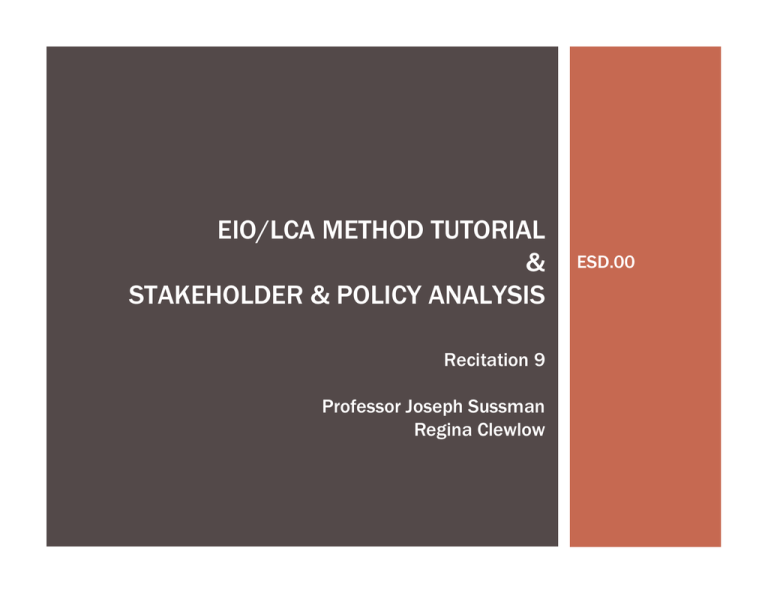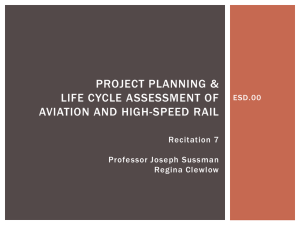
EIO/LCA METHOD TUTORIAL
&
STAKEHOLDER & POLICY ANALYSIS
Recitation 9
Professor Joseph Sussman
Regina Clewlow
ESD.00
LIFE CYCLE ASSESSMENT OF TRANSPORTATION
SYSTEMS: GOAL & SCOPE
Components considered in this analysis
Adapted from
Chester, “Life-cycle Environmental Inventory of Passenger Transportation Modes in the United States”
APPROACHES TO LCA: ECONOMIC I/O
Economic Input-Output
method.
Uses information about
monetary transactions
between sectors.
Most nations create
economic input-output
tables every so many
years (e.g. U.S. models
created every 5 years).
To combine LCA with EIO,
traditional economic I/O
models are appended
with information on
emissions.
Sample Input-Output Table
Industry
Producing
Agriculture
Agriculture
Food &
Lumber & Furniture & Paper & Allied
Textiles Apparel
Beverages
Wood
Fixtures
Products
10.86
15.70
2.16
0.02
Food & beverages
2.38
5.75
0.06
0.01
Textiles
0.06
1.30
3.88
0.29
0.04
9.84
Apparel
0.04
0.20
1.96
0.01
0.02
13.32
Lumber & wood
0.15
0.10
0.39
0.27
6.00
0.01
0.01
2.89
0.02
2.60
7.90
2.89
7.90
1.00
0.01
Furniture & fixtures
Paper & allied products
Total Outlays
0.02
0.19
Total Output
44.26
0.52
0.08
0.02
40.30
9.84
13.32
6.00
0.01
44.26
0.03
40.30
Figures in billions of U.S. dollars
Adapted from eiolca.net, Green Design Institute
Image by MIT OpenCourseWare.
EIOLCA: AIRCRAFT MANUFACTURING EXAMPLE
Step 1:
Choose a Model
Models available for 1992,
1997, 2002.
2002 is a Producer Price
model (“cradle to gate”) –
does not include
distribution costs to
consumer.
Important to use the same
model to compare HSR
and aviation.
Suggested model: 2002.
Adapted from eiolca.net, Green Design Institute
© www.eiolca.net. All rights reserved. This content is excluded from our
Creative Commons license. For more information, see
http://ocw.mit.edu/fairuse.
EIOLCA: AIRCRAFT MANUFACTURING EXAMPLE
Step 2: Select Industry &
Sector
The model divides the
economy into 428 divisions
grouping businesses that
produce similar goods or
services, or that use similar
processes.
Can either search for a sector
by keyword.
In this case, select “Aircraft
manufacturing” (note that this
only includes the aircraft
frame – we’ll look at engines
separately).
Adapted from eiolca.net, Green Design Institute
© www.eiolca.net. All rights reserved. This content is excluded from our
Creative Commons license. For more information, see
http://ocw.mit.edu/fairuse.
EIOLCA: AIRCRAFT MANUFACTURING EXAMPLE
Intermediate Step:
Determine Costs
For Step 3, you must have
an estimate of costs for
the components or
processes of interest.
The commercial price of
an average Boeing 737700 is $67.9 million.1 (see
link below for data on the
full 737 family).
We will deduct the engine
price, and assume a 10%
markup.
Description
Amount
Boeing 737-700
(commercial price)
$67.9 M
CFMI CFM56-7
$6 M
Engine (per engine)2
Boeing 737-700
minus Twin Engines
$55.9 M
Boeing 737-700
minus 10% markup
= ($55.9 M/1.1)
$50.8 M
Adapted from eiolca.net, Green Design Institute
1: http://www.boeing.com/commercial/prices/
2: http://www.cfm56.com/press/news/cfm+logs+$600+million+cfm56-7b+engine+orders/129
EIOLCA: AIRCRAFT MANUFACTURING EXAMPLE
Step 3: Enter the
Amount of Economic
Activity
We computed the level of
economic activity
associated with the
production of one (1)
aircraft frame on the
previous slide.
Enter $50.8 M for this
example.
Adapted from eiolca.net, Green Design Institute
© www.eiolca.net. All rights reserved. This content is excluded from our
Creative Commons license. For more information, see
http://ocw.mit.edu/fairuse.
EIOLCA: AIRCRAFT MANUFACTURING EXAMPLE
Step 4: Select Category
of Results
Select the type of result
to display (e.g.
Greenhouse gas
emissions, Energy).
Select “Energy” for this
example.
Adapted from eiolca.net, Green Design Institute
© www.eiolca.net. All rights reserved. This content is excluded from our
Creative Commons license. For more information, see
http://ocw.mit.edu/fairuse.
EIOLCA: AIRCRAFT MANUFACTURING EXAMPLE
Step 5:
Run the Model
Click “Run Model”.
Results should provide
you with amount of
energy (in terajoules) to
manufacture one (1)
aircraft.
You’ll then use this figure
to determine the amount
of energy required over
the aircraft’s lifetime.
Adapted from eiolca.net, Green Design Institute
© www.eiolca.net. All rights reserved. This content is excluded from our
Creative Commons license. For more information, see
http://ocw.mit.edu/fairuse.
STAKEHOLDERS
In the case of high-speed rail and aviation infrastructure
investment, who are the stakeholders?
STAKEHOLDERS
In the case of high-speed rail and aviation infrastructure
investment, who are the stakeholders?
Citizens where high-speed rail and aviation services are being
considered.
Citizens whose home/land may be affected by transportation
expansion.
Environmental groups.
The airline and high-speed rail industries.
POLICY IMPLICATIONS
Historical and current status of high-speed rail in the U.S.
Historically, limited support for passenger rail investment in the U.S.
A new president who strongly support HSR investment.
An issue that has become highly politicized.
Potential policy implications of this analysis:
Help to make the environmental impacts of aviation and high-speed rail more
transparent – to support decision-making.
If we find that high-speed rail is not as environmentally-friendly as compared
with aviation, what are the implications?
MIT OpenCourseWare
http://ocw.mit.edu
ESD.00 Introduction to Engineering Systems
Spring 2011
For information about citing these materials or our Terms of Use, visit: http://ocw.mit.edu/terms.



